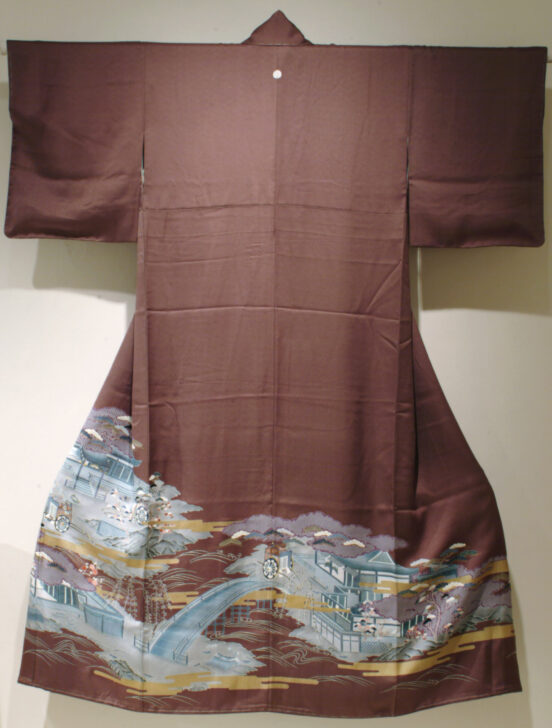Formal mauve crested kimono with painted palace scene
Japanese

Description
Gallery Rotation Winter 2013
Kimono
Japan, Showa period (1926–1989)
1970s
Mauve silk damask with woven diaper pattern and gold designs
Gift of Howard and Patricia Yamaguchi, 2005/1.381
This kimono, with a grand scene of a Heian period (794–1185) aristocratic residence, is an example of formal wear for a middle-aged woman. Called hômongi (visiting wear), this type of dress is appropriate for occasions such as New Year’s Day celebrations or the wedding of a niece or nephew. For a married woman, the most formal wear is a black crepe silk kimono with painted designs on the left shoulder and hem and five small family crests at the back of the neck and on the sleeves. This kimono is less formal: the silk has been dyed a lovely shade of purple rather than black and there is only one family crest.
In hômongi the asymmetrical patterning wraps without interruption from the front across the side seams to the back hem. The only other motif (here a delicate willow tree) appears below the side of one shoulder. Hômongi motifs are often drawn from the classics and refer to Heian court culture. This elegant, hand-painted scene is based on the Tale of Genji, the popular story of the amorous prince Hikaru Genji. The empty cart suggests that he is visiting one of his lovers’ residences.
Subject Matter:
This example of formal kimono has only one family crest, as opposed to five used in the most formal type. The design of an elaborate palace was painted by hand.
Physical Description:
Mauve (adzuki iro) silk damask in woven T-diaper pattern (sayagata) with yûzen painted and stenciled gold designs. Upper lining is double-layered white silk; below is self-lined (mauve-kimono silk).
Usage Rights:
If you are interested in using an image for a publication, please visit https://umma.umich.edu/request-image/ for more information and to fill out the online Image Rights and Reproductions Request Form.